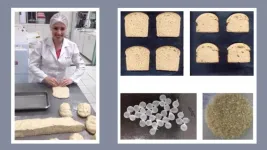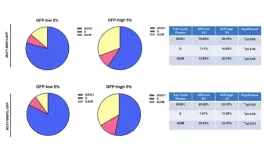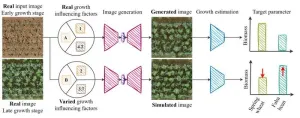(Press-News.org) Brazilian researchers have developed functional bread with the potential to prevent asthma, a respiratory disorder responsible for some 350,000 hospitalizations per year in the SUS (Sistema Único de Saúde), the nation’s public healthcare network.
The formulation, for which a patent application has been filed in Brazil (BR1020210266465), is described in an article published in the journal Current Developments in Nutrition. It contains Saccharomyces cerevisiae UFMG A-905, a strain of brewer’s yeast with probiotic properties that has been shown to attenuate the symptoms of asthma in mice (read more at: agencia.fapesp.br/40733). Further trials involving human volunteers are still required.
One of the most common diseases in the world, asthma is increasingly frequent and affects some 20 million Brazilians, according to the database maintained by the Ministry of Health (DATASUS). It is characterized mainly by airway inflammation and hyperresponsiveness. Its exact causes are poorly understood, but it is known to be associated with environmental irritants, diet, and gut microbiota, among other factors.
Asthmatic patients can benefit from ingestion of probiotics thanks to the link with gut microbiota. These beneficial bacteria are typically administered on their own or blended with dairy products such as milk, yogurt and kefir, but nothing prevents the use of other vehicles, which is advisable for patients who suffer from lactose intolerance or milk protein allergy.
In this study, which was funded by FAPESP, researchers at the University of São Paulo (USP) included S. cerevisiae UFMG A-905 in naturally fermented bread for the first time. Groups at the State University of Campinas (UNICAMP) and the Federal University of Minas Gerais (UFMG) collaborated on the project.
To assess its potential, the researchers tested and compared three types of bread. The first was fermented with commercial yeast, the second with S. cerevisiae UFMG A-905, and the third with S. cerevisiae UFMG A-905 plus microcapsules containing live S. cerevisiae UFMG A-905.
“We added encapsulated live yeast in order to improve probiotic viability and activity at the high temperature reached during the baking process,” said Marcos de Carvalho Borges, last author of the article and a professor in the Department of Clinical Medicine at the Ribeirão Preto Medical School (FMRP-USP). “Microcapsules protect bioactive and probiotic compounds, improving their stability, survival and bioavailability.”
Mice with asthma were fed the different types of bread for 27 days. At the end of the experiment, the mice fed S. cerevisiae UFMG A-905 bread displayed less airway inflammation and lower levels of asthma biomarkers (interleukins 5 and 13, or IL5 and IL13, which are proteins secreted by the immune system).
In mice fed the bread containing microencapsulated yeast, airway hyperresponsiveness and levels of IL17A, another biomarker of asthma, were also reduced. These results were similar to those of previous studies, confirming that live S. cerevisiae UFMG A-905 can help prevent asthma.
“We found that both types of bread fermented with S. cerevisiae UFMG A-905 prevented the development of asthma in the mice, which in conjunction with the results of other experiments shows that this yeast has highly consistent effects and appears genuinely capable of combating this respiratory disorder,” Borges said.
Next stage: clinical trial
While acknowledging the limitations of the study, such as not including bread fermented with commercial yeast plus microcapsules and not assessing the survival of S. cerevisiae UFMG A-905 microcapsules after baking, the scientists believe they can now take the next step, which will consist of developing a protocol for a clinical trial to observe the effects of the yeast on human beings.
“The product has significant potential,” Borges said. “Bread is a natural food consumed by almost everyone including children. It’s easily distributed and has a good half-life on the shelf.”
The study was also funded by the Ministry of Education’s Coordination for the Improvement of Higher Education Personnel (CAPES). The other co-authors of the article are Ana Paula Carvalho Thiers Calazans and Thamires Melchiades Silva Milani, researchers affiliated with FMRP-USP; Ana Silvia Prata and Maria Teresa Pedrosa Silva Clerici, professors at UNICAMP’s School of Food Engineering (FEA); and Jacques Robert Nicoli and Flaviano Santos Martins, professors at UFMG’s Institute of Biological Sciences (ICB).
About São Paulo Research Foundation (FAPESP)
The São Paulo Research Foundation (FAPESP) is a public institution with the mission of supporting scientific research in all fields of knowledge by awarding scholarships, fellowships and grants to investigators linked with higher education and research institutions in the State of São Paulo, Brazil. FAPESP is aware that the very best research can only be done by working with the best researchers internationally. Therefore, it has established partnerships with funding agencies, higher education, private companies, and research organizations in other countries known for the quality of their research and has been encouraging scientists funded by its grants to further develop their international collaboration. You can learn more about FAPESP at www.fapesp.br/en and visit FAPESP news agency at www.agencia.fapesp.br/en to keep updated with the latest scientific breakthroughs FAPESP helps achieve through its many programs, awards and research centers. You may also subscribe to FAPESP news agency at http://agencia.fapesp.br/subscribe.
END
Brazilian scientists develop functional bread to help prevent asthma
Bread produced with probiotic yeast performed well in experiments with mice, showing potential to combat asthma, which affects 20 million Brazilians.
2024-06-17
ELSE PRESS RELEASES FROM THIS DATE:
Potential new treatment option for diabetic retinopathy
2024-06-17
Potential New Treatment Option for Diabetic Retinopathy
OU researcher developing potential new treatment for diabetic retinopathy that could address the problem much earlier.
OKLAHOMA CITY, OKLA. – Patients with diabetes face a host of potential health problems as they work to manage the chronic disease. Still, one concern that seems to weigh heavily is the risk of losing their sight through a condition known as diabetic retinopathy.
Researchers at the University of Oklahoma Health Sciences and Memorial Sloan Kettering (MSK) Cancer Center are studying a new, revolutionary treatment for diabetic retinopathy that could change the prognosis ...
Paternal use of metformin during sperm production not associated with major birth defects
2024-06-17
Embargoed for release until 5:00 p.m. ET on Monday 17 June 2024
Annals of Internal Medicine Tip Sheet
@Annalsofim
Below please find summaries of new articles that will be published in the next issue of Annals of Internal Medicine. The summaries are not intended to substitute for the full articles as a source of information. This information is under strict embargo and by taking it into possession, media representatives are committing to the terms of the embargo not ...
American diets have a long way to go to achieve health equity
2024-06-17
Poor diet continues to take a toll on American adults. It’s a major risk factor for obesity, type 2 diabetes, cardiovascular disease, and certain cancers, and more than one million Americans die every year from diet-related diseases, according to the Food and Drug Administration. Poor diet and food insecurity is also costly, attributing to an estimated $1.1 trillion in healthcare expenditures and lost productivity. These burdens also contribute to major health disparities by income, education, zip code, race, and ethnicity.
In a study from the Food is Medicine Institute at the Friedman School of Nutrition Science and Policy at Tufts University published today in ...
New ‘aging atlas’ provides a detailed map of how cells and tissues age
2024-06-17
A new aging atlas gives scientists an in-depth view of how individual cells and tissues in worms age and how different lifespan-extending strategies might stop the clock.
Aging impacts all the tissues in our body – from our muscles to our skin. Figuring out how individual tissues and cells age could help researchers better understand the aging process and aid in the development of anti-aging treatments.
Due to their short lifespans, simple body plans, and genetic similarity to humans, many researchers study aging in roundworms. To look at aging at the level of tissues and cells, a team of researchers from HHMI's Janelia ...
New technology allows researchers to precisely, flexibly modulate brain
2024-06-17
By Beth Miller
Human brain diseases, such as Parkinson’s disease, involve damage in more than one region of the brain, requiring technology that could precisely and flexibly address all affected regions simultaneously. Researchers at Washington University in St. Louis have developed a noninvasive technology combining a holographic acoustic device with genetic engineering that allows them to precisely target affected neurons in the brain, creating the potential to precisely modulate selected cell ...
Origins of cumulative culture in human evolution
2024-06-17
Each of us individually is the accumulated product of thousands of generations that have come before us in an unbroken line. Our culture and technology today are also the result of thousands of years of accumulated and remixed cultural knowledge.
But when did our earliest ancestors begin to make connections and start to build on the knowledge of others, setting us apart from other primates? Cumulative culture — the accumulation of technological modifications and improvements over generations — allowed humans to adapt to a diversity of environments and challenges. But, it is unclear when cumulative culture first developed during hominin evolution.
A study published ...
Mitophagy and cancer: BNIP3/BNIP3L’s role in stemness, ATP production, proliferation, and cell migration
2024-06-17
“[...] our current work has provided a novel strategy to enrich for a sub-population of cancer cells, with high basal levels of mitophagy.”
BUFFALO, NY- June 17, 2024 – A new research paper was published on the cover of Aging (listed by MEDLINE/PubMed as "Aging (Albany NY)" and "Aging-US" by Web of Science) Volume 16, Issue 11, entitled, “Mitophagy and cancer: role of BNIP3/BNIP3L as energetic drivers of stemness features, ATP production, proliferation, and cell migration.”
Mitophagy is a selective form of autophagy which permits ...
Breakthrough approach enables bidirectional BCI functionality
2024-06-17
Brain-computer interfaces or BCIs hold immense potential for individuals with a wide range of neurological conditions, but the road to implementation is long and nuanced for both the invasive and noninvasive versions of the technology. Bin He of Carnegie Mellon University is highly driven to improve noninvasive BCIs, and his lab uses an innovative electroencephalogram (EEG) wearable to push the boundaries of what’s possible. For the first time on record, the group successfully integrated a novel focused ultrasound stimulation to realize bidirectional BCI that both encodes and decodes brain waves using machine learning in a study with 25 human subjects. This work opens ...
Polarization and risk perception could play important roles in climate-policy outcomes
2024-06-17
Times of crises often call for strong and rapid action, but in polarized societies, strong top-down policies can backfire.
In a paper published on June 17, 2024, in Environmental Research Letters, SFI Applied Complexity Fellow Saverio Perri, SFI Science Board Fellow Simon Levin (Princeton University), and colleagues present a conceptual model of how these dynamics could play out in efforts to decarbonize our energy supply. The model illustrates the complex interplay between strong policies, people’s perception of risk, and the amount of polarization in a society. They show that in situations where the perception of risk is low — where the ...
AI shows how field crops develop
2024-06-17
Researchers at the University of Bonn have developed software that can simulate the growth of field crops. To do this, they fed thousands of photos from field experiments into a learning algorithm. This enabled the algorithm to learn how to visualize the future development of cultivated plants based on a single initial image. Using the images created during this process, parameters such as leaf area or yield can be estimated accurately. The results have been published in the journal Plant Methods.
Which plants should I combine ...
LAST 30 PRESS RELEASES:
University of Phoenix College of Doctoral Studies releases white paper on AI-driven skilling to reduce burnout and restore worker autonomy
AIs fail at the game of visual “telephone”
The levers for a sustainable food system
Potential changes in US homelessness by ending federal support for housing first programs
Vulnerability of large language models to prompt injection when providing medical advice
Researchers develop new system for high-energy-density, long-life, multi-electron transfer bromine-based flow batteries
Ending federal support for housing first programs could increase U.S. homelessness by 5% in one year, new JAMA study finds
New research uncovers molecular ‘safety switch’ shielding cancers from immune attack
Bacteria resisting viral infection can still sink carbon to ocean floor
Younger biological age may increase depression risk in older women during COVID-19
Bharat Innovates 2026 National Basecamp Showcases India’s Most Promising Deep-Tech Ventures
Here’s what determines whether your income level rises or falls
SCIE indexation achievement: Celebrate with Space: Science & Technology
Children’s Hospital Colorado performs region’s first pediatric heart and liver dual organ transplant
Australian team discover why quantum computers have memory problems over time
What determines the fate of a T cell?
Candida auris: genetic process revealed which could be treatment target for deadly fungal disease
Groundbreaking discovery turns household plastic recycling into anti-cancer medication
Blocking a key inflammatory pathway improves liver structure and vascular function in cirrhosis, study finds
Continuous spread: Raccoon roundworm detected in nine European countries
HKUST Engineering researchers developed a novel photodetector to enhance the performance of on-chip light monitoring
Strategic river sensors could have forewarned of Texas Camp flood disaster
Drone sampling of whale breath reveals first evidence of potentially deadly virus in Arctic
Roman soldiers defending Hadrian’s Wall infected by parasites, study finds
Pinochet’s prisoners were tormented with music but still found solace in it, a new book reveals
Fertility remains high in rural Tanzania despite access to family planning
AI-assisted device can improve autism care access
Kinetic careers
Uncovering how parasitic plants avoid attacking themselves to improve crop resistance
Nanoparticle vaccine strategy could protect against Ebola and other deadly filoviruses
[Press-News.org] Brazilian scientists develop functional bread to help prevent asthmaBread produced with probiotic yeast performed well in experiments with mice, showing potential to combat asthma, which affects 20 million Brazilians.





